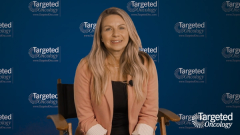
Recent Long-Term Data on PARP Inhibitors in Ovarian Cancer
Leslie Randall, MD, MAS, reviews recent long-term data on PARP inhibitors in the treatment of ovarian cancer.
Episodes in this series

Case: A 55-Year-Old Woman with BRCA-Mutated Ovarian Cancer
- A 55-year-old presents to her PCP for heartburn and abdominal pain that started approximately 2 years earlier.
- Imaging: Transvaginal US showed bilateral ovarian masses; CT reveals masses in adnexa, largest measuring 5.8 cm, with evidence of liver capsule and retroperitoneal lymph node involvement.
- Labs: CA125, 3600 U/mL
- Surgical intervention: She underwent hysterectomy, omentectomy, appendectomy, and debulking; residual disease was left on liver and diaphragm, approximately 2.2 cm
- Diagnosis: stage IIIc, high-grade serous ovarian cancer
- IHC testing: p53 (+)/ PAX 8 (+) /WTI and CK 7 (+)
- Germline testing: BRCA1 mutation
- Treatment: She received IV carboplatin/paclitaxel
- TRAEs: She experienced myelosuppression, most notably neutropenia (post cycle 3) that required postponement of next cycle
- Follow-up imaging: showed complete clinical remission after completion of chemotherapy; CA125, 30.5 U/mL
- Maintenance therapy with a PARPi was initiated.
- At week 3, her hemoglobin is 7.0 g/dL and she receives a transfusion
Transcript:
Leslie Randall, MD, MAS: As these datasets continue to mature, we’re getting some good, updated data from our most recent meetings. For example, [in] the PRIMA trial [NCT02655016] [results presented]at the ESMO [European Society for Medical Oncology] meeting this year, we saw updated progression-free survival data that did in fact confirm what we saw in the initial data, that there is significant benefit for both [patients carrying] BRCA [mutations] and [patients]with homologous recombination deficient (HRD)cancers. There was less of an effect with the [patients with homologous recombination proficient cancers], but still a hazard ratio of 0.68. It’s not insignificant. The hazard ratios for bevacizumab and cross-trial comparisons, as always, are not statistically valid, but they do help us get an idea of how we make decisions for our patients. [Bevacizumab’s hazard ratio] is 0.71, right in the same ballpark as a bevacizumab alone in that group of patients.
The [data from the] SOLO-1 trial [NCT01844986] are starting to show an impressive overall survival advantage for patients who carry BRCA mutations. This is why all patients with BRCA mutations should get a PARP inhibitor. We’re starting to talk about whether or not these patients are potentially cured with PARP inhibitors, which is incredibly exciting when you talk about stage 3 and 4 ovarian cancer. We never had that potential before. We always considered stage 3 and 4 ovarian cancer to be not curable. That’s not necessarily the case now that we have PARP inhibitors for our [patients carrying] BRCA [mutations]. Again, these SOLO-1 data are continuing to support that. The PAOLO-1 trial [NCT02477644] data [are] again supporting an overall survival advantage for patients who do carry BRCA mutations and for the HRD-positive group and even showing trends in the HR-proficient group. This PARP inhibitor in the front line is extremely important for these patients.The other important point to note with the extended data sets is that the [myelodysplastic syndromes and acute myeloid leukemia] rates are still low even with this longer-term data, so still around 1% in the frontline setting.
Transcript edited for clarity.








































